CBER Presentation
Issues with Malaria Screening in the US
Australian experience with malaria antibody screening and feasibility of implementing such a "process" in the US for selected populations versus universal donor screening
FDA Workshop on Testing for Malarial Infections in Blood Donors
July 12, 2006
Susan L. Stramer, Ph.D.
Executive Scientific Officer
American Red Cross
Outline
- Current donor questioning process
- Post donation information
- Donor deferrals, 2000-2005
- Australian experience US testing options
Donor Questioning
- Question #40: Have you ever had malaria?
- No: accept the donor
- Yes: have you been asymptomatic for > 3 years?
- Yes: accept the donor
- No: defer the donor
- Question #29: In the past 3 years have you been outside the US or Canada?
- No: accept the donor
- Yes: in what countries?
- Only if non-malarial areas, no time in Iraq; accept the donor
- Yes malarial areas or Iraq; have you lived > 5 yrs in another country?
- No: defer 12 mos after recent travel or departure from Iraq
- Yes: what country and what area? Determine how long since donor departed from malarial area
- Defer for 3 yrs after departure (resident) or 12 mos after travel/departure from Iraq
- Non-malarial area: defer 12 mos from travel or after departure from Iraq
Assessment of Donor Eligibility Based on Travel/Residence to a Malarial Area
- Health historians provided:
- Reference Listing: countries by region to assist in identifying general areas
- Reference Tables (drop down menus; eBDR): alphabetized listing by country of risk, destinations within a country
- Not all inclusive; questions: refer to CDC's Health Information for International Travel
- Countries with no risk listed by name
- Many countries have cities of the same name in several different provinces or states
- If more information is needed, consult
- Hammond Atlas (distributed to all collection staff)
- If cannot determine, defer donor and consult with BHQ
Acceptance of an Ineligible Donor-Malaria by Month of Occurrence
N=1176
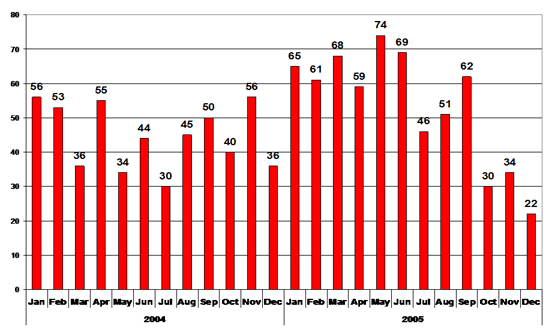
Acceptance of an Ineligible Donor
by Month of Occurrence
N=1176 Malaria (47%); Other 1344 = 2520 Total
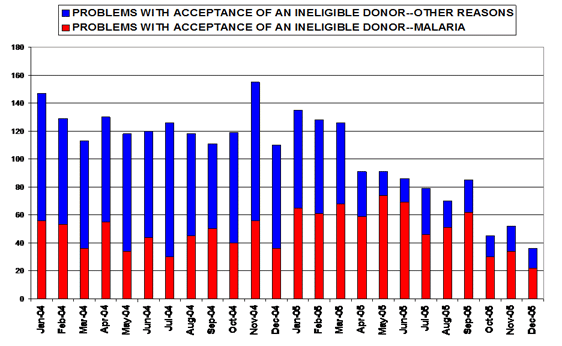
Violative BPD Reports-Acceptance Of An Ineligible Donor-Malaria-by Month of Occurrence
N=144/1176 (12%)
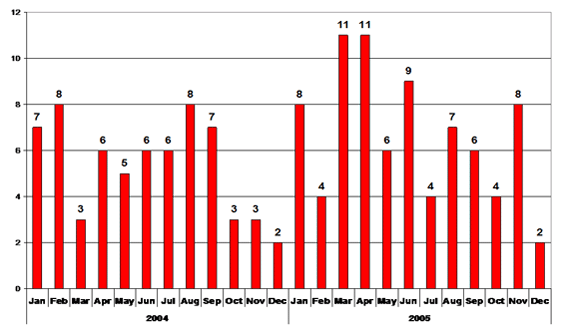
Violative BPD Reports
Acceptance of an Ineligible Donor - Malaria
CY 2004 and 2005-Involved Country
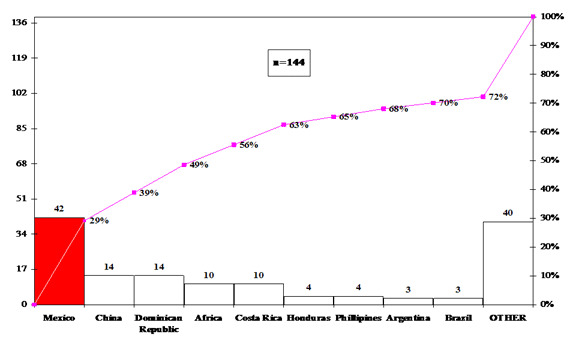
Complexity of Questioning
- Chinese Provinces with risk in rural areas: Hainan, Yunnan, Fujin, Guangdong, Guangxi, Guizhou, Sichuan, Xizang (Zangbo River valley only), Anhui, Hubei, Hunan, Jiangsu, Jiangxi and Shandong
- Defer if area visited was:
- < 1500m only during warm weather
- N of latitude 33ºN, July-Nov
- Between latitude 25ºN and 33ºN, May-Dec
- South of latitude 25ºN, year round
- Complexity leads to deferral of all donors
Complexity of Questioning
- Mexico; do donors know states of travel?
| Location Monterrey (in 7 states) | States | Malarial Risk |
| Nuevo Leon | No | |
| Campeche | Risk | |
| Chiapas | Risk | |
| Durango | No | |
| Sinaloa | Risk | |
| Sonora | No | |
| Tabasco | Risk |
Post Donation Information-- Malaria by Month of Occurrence
N=6918 total with or without associated products
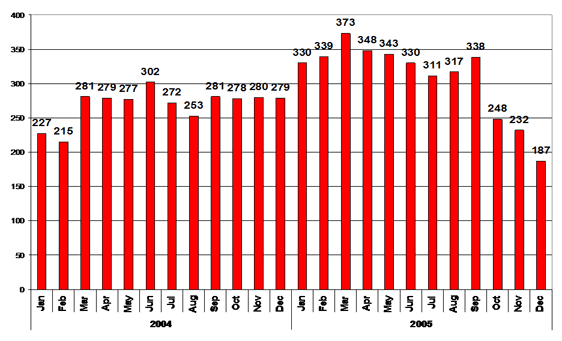
Post Donation Information Related to Behavior/History
by Month of Occurrence
N=6918 Malaria (39%); Other 11,018 = 17,936 Total
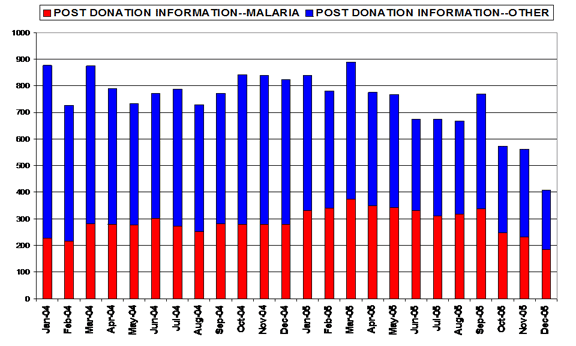
Post Donation Information--Malaria
by Month of Occurrence
N=6281 with associated products/6918 total = 91%
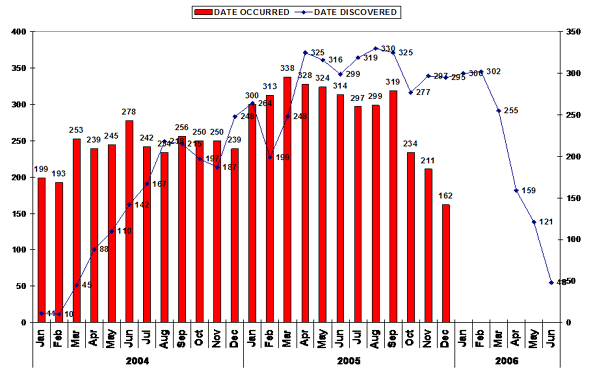
23,611,536 Presenting Donors
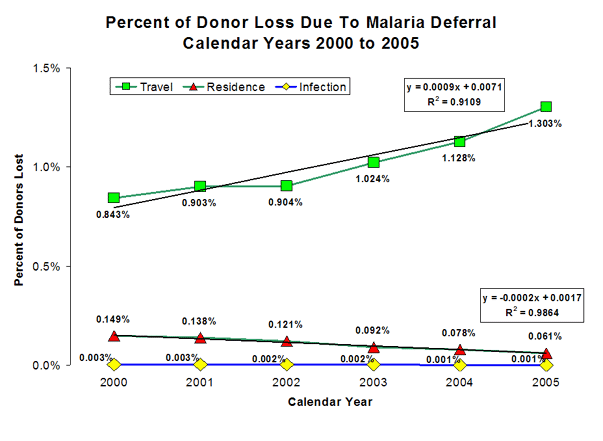
Total Malaria Deferrals
2000-2005
23,611,536 Presenting Donors
| No. | % | Annual mean donation rate | Projected no. total lost donations | |
| Travel | 241,777 | 1.01 | 1.69 | 410,844 |
| Residence | 25,339 | 0.11 | 1.69 | 42,635 |
| Malaria | 495 | 0.002 | 1.69 | 831 |
| Total | 267,611 | 1.13 | 454,310 |
Total Malaria Deferrals
2005
3,795,204* Presenting Donors
| No. | % | Annual mean donation rate | Projected no. total lost donations | |
| Travel | 50,119 | 1.303 | 1.725* | 86,455* |
| Residence | 2309 | 0.061 | 1.725 | 3983 |
| Malaria | 53 | 0.001 | 1.725 | 91 |
| Total | 52,481 | 1.365 | 90,529 |
* 6,546,727 donor presentations projected 86,455 lost donations due to travel deferrals; US ABC 2005 data = 7, 133,005 donor presentations with 83,066 (1.2%) malaria travel deferrals
Opportunity Losses Lifetime
- 2005 total losses, 52,481 presenting donors
- Will show that most are FT donors in all categories (>80%) and most (<10%) never return over observed period
- 10-year follow up FT donors to determine return frequencies (assuming same pattern for malaria deferred donors); 1995-2005
- 505,695 of 1,016,110 FT donors returned (50%)
- Median 3.3/mean 5.7 career donations
- 2-226 range
- 4.34 years
- Convert 2005 travel deferrals of 50,119 into lifetime donors = 285,678 career donations (mean)
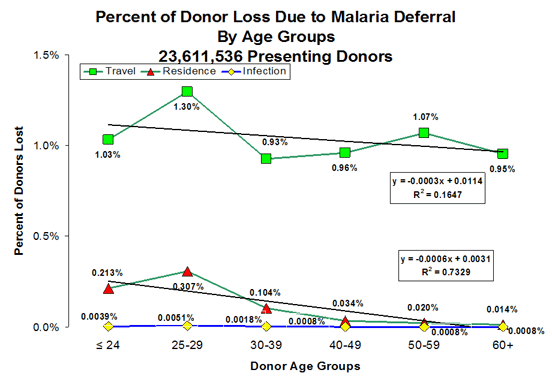
Malaria Deferred Donor Characteristics
Infection, 2000-2005
23,611,536 Presenting Donors
| Total | 492 (3 deferred twice) = 495 presentations |
| FT | 479 (97.4%) |
| RPT | 13 (2.6%); 2 donors with 2 prior donations |
| Males | 290 (58.9%) |
| Returned | 4 (0.8%); 1-2 donations/donor |
Malaria Deferred Donor Characteristics
Residence, 2000-2005
23,611,536 Presenting Donors
| Total | 25,169 (167 deferred 2-3X) = 25,339 presentations |
| FT | 24,253 (96.4%) |
| RPT | 916 (3.6%); 226 donors with 2 prior donations |
| Males | 15,392 (61.2%) |
| Returned | 338 (1.1%); 2-7 donations/donor |
Malaria Deferred Donor Characteristics
Travel, 2000-2005
23,611,536 Presenting Donors
| Total | 237,307 (4302 deferred 2, 3 or 4X) = 241,777 presentations |
| FT | 196,398 (82.8%) |
| RPT | 40,909 (17.2%); 11,892 donors with 2-21 prior donations |
| Males | 118,145 (49.8%) |
| Returned | 13,274 (5.6%); 2-23 donations/donor |
Malaria Deferred Donor Collection Regions
2000-2005
23,611,536 Presenting Donors
- High by collections: Oakland/Tulsa (infection), LA/Oakland (residence), Oakland (2.4%)/LA (1.6%) (travel)
- Low by collections: Omaha/PR (0) (infection), Toledo/PR (residence), Birmingham (0.4%)/PR (0.3%) (travel)
- US ABC data range (2005): min 0.7% Gulf coast area to 2.0% max on the East coast
Top Ten Deferral Categories, 2005, N (%)
| Low hemoglobin | 691,950 | 65.22% |
| Unacceptable blood pressure | 46,575 | 4.39 |
| Travel-malaria | 50,120 | 4.72 |
| Rapid pulse rate | 26,007 | 2.45 |
| Current infection/antibiotics | 25,983 | 2.45 |
| 12 mo, other blood exposure; e.g., needle stick, tattoo, body piercing, snorted cocaine | 19,085 | 1.80 |
| Cancer ever | 17,280 | 1.63 |
| 3 mo outside US;1980-96 (UK) | 13,722 | 1.29 |
| Don't feel well today | 11,874 | 1.12 |
| Chest pain (6 mo) | 10,151 | 0.96 |
Impact of Malaria Deferrals by Country of Travel
6 REDS-II Centers, 12,310 deferrals/1.25 million allogeneic donations, 30-day travel recorded
| Travelers to: (x 10^6) in 2003 |
# Imported Malaria Cases (US civilians) | Rate Imported Malaria/10^6 travelers | Malaria Travel by Area | Projected # Deferred Donors/Year |
| Africa (0.21) | 561 (94x) | 2683 (8000x)* | 2.3% | 3400 |
| Mexico (17.56) (84x) | 6 | 0.34 | 41.1% | 59,650 |
| Central America Caribbean (6.78) |
59 | 8.71 | 38.4% | 55,700 (80%) |
| S America (1.85) | 21 | 11.38 | ||
| Asia/W Pacific (4.26) | 109 | 25.57 | 16.0 | 23,250 |
| 756 | *91x Amer | 97.8 | 142,000 |
Spencer et al., AABB 2006
Donors Implicated in Transfusion Transmitted Malaria, US, 1963-99
| N=64 (of 67) imp.donors |
1963-69 (N=11) |
1970-79 (N=24) |
1980-89 (N=17) |
1990-99 (N=12) |
|---|---|---|---|---|
| Number (%) | ||||
| Resident mal area | 4 (36) | 5 (21) | 15 (88) | 10 (83) |
| US civilian traveler | 0 | 2 (8) | 0 | 1 (8) |
| Visit friends/rel | 1 (9) | 4 (17) | 2 (12) | 1 (8) |
| US military | 6 (55) | 13 (54) | 0 | 0 |
Mungai et al., NEJM, 1999
Region of Acquisition; Imported US Malaria by species (2002)
| Plasm. | falcip | vivax | mal | ovale | unk | mix | Total |
| Africa | 613 | 71 | 30 | 30 | 153 | 6 | 903 |
| Asia | 18 | 130 | 3 | 3 | 14 | 3 | 171 |
| Cental Am/Carib | 23 | 62 | 1 | 1 | 9 | 0 | 96 |
| N Amer | 2 | 7 | 0 | 0 | 1 | 0 | 10 |
| S Amer | 8 | 19 | 2 | 1 | 5 | 0 | 35 |
| Oceania | 5 | 23 | 1 | 0 | 7 | 0 | 33 |
| unk | 29 | 24 | 0 | 1 | 24 | 2 | 80 |
| Total | 698 | 336 | 37 | 37 | 213 | 11 | 1332 |
MMWR ss-1 2004
Australian (ARCBS) Experience
- 1991 - Last case of TTM; fatal
- At 1 million donations per year, risk is < 1 per 10 million
- Donor deferral rate due to questioning infection/residence/travel = appr.5%
- 20,000 deferred/472,000 presenting donors per year (x1.92 dntns/year=908,000/yr + other =1.08 million)
- 50% of current discard of red cells
- Yes to question: in all cases, distribute frac plasma only (so donors are still donating)
- Deferral = cessation of distribution of cellular components
- 95.5% travelers (within past 12 mos but stayed < 6 continuous mos; i.e., not a resident); 12-mo deferral
- Risk area defined by WHO
- 4.4% residents (>6 continuous mos within the past 3 years; i.e., to detect significant recent exposure); 3-yr deferral
- < 0.1% infection (but recovered); 3 yr-deferral
- Questioning as protection, "Any process reliant on assessors eliciting and recording accurate information has a significant error rate"
- July 17, 2005 implement "testing in" strategy for any deferred donor
- Modeled after the UK NBS (Kitchen et al., 2004 Vox Sang)
- > 4 mos elapsed since leaving a malarial area or recovery/cessation of symptoms of prior infection (compliant with Council of Europe)
- If >3 years passed, no testing required
- Collect donation (quarantine red cells)
- Test recombinant malaria Ab test for Pf/Pv (Newmarket EIA, Newmarket Labs, Ltd, UK)
- Pm/Po detection by cross reactivity (50-70% for Po)
- Pm/Po represent 3% and 1% of malaria cases in Australia
- Last TTM Pm case 1956
- TGA approved based on low frequency of Pm/Po; cross rx; and 4-month "embargo"
- If test neg: release red cells for transfusion; donor deferral removed unless re-visit other malarial areas
- Note, logistical challenges (IT and collection staff) to trigger testing and quarantine red cells; one process recall to date
- Results (7/17/05-3/30/06)
- 26,356 donors screened (visitors/residents/prev infection); Sydney
- + 18,145 (77%) subsequent donations
- RR rate = 2.28% (602); pilot 2.3%; Seed et al., 2005 Vox Sang 88
- Each RR tested to determine evidence of parasitemia
- Binax (Portland, ME)/NOW Pf/Pv Ag dipstick (sens 100 parasites/uL)
- 93.4% sens (100% Pf, 89% Pv); Pm/Po cross rx
- 96-98% spec
- Whole blood w/in 72h
- Artus RealArt Rotorgene PCR (Artus Biotech, Germany) (sens 1 parasite/uL)
- Pos Ag (+/-PCR) referred for clinical assessment: probable parasitemic
- Each RR notified (letter for MD stating Ab RR to explain any febrile illness); again restricted to donating only frac plasma until Ab nonreactive
- No Ag or PCR positives to date
- July 2006 (first week), first probable parasitemic donor
- Indian resident who migrated to Australia in 2005, completely asymptomatic
- RR Newmarket EIA (high signal)
- Ag weak Pf band (repeated)
- PCR negative
- Follow up pending
- Referred to ID specialist
- Within predicted rate
- Of analyzed data: RR/total tested
- Travel: 216/20,780 (1.0%)
- Residence: 138/1550 (8.9%)
- Infection : 15/50 (30%)
- Recovery: to May 06 = 32,000 index red cells (minus Queensland, 20% of supply)
- Exceeds predictions of 26,000 (included Queensland)
- Hidden deferrals (donors not retained as frac plasma donors)
Testing Options:
Universal Screening (Ab only vs Ab + NAT)
Ab "Testing In" (Australian model)
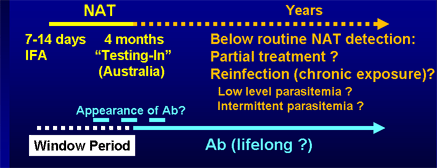
Current deferrals based on:
- 97% of malaria cases in travelers occur within 1 year of living in the risk area
- 99% of malaria cases in residents occur within 3 years
Testing Options: Ab "Testing In" (Australian Model)
PROS
- Shortens deferral period (from 12 mos-3yrs to 4 months)
- Aus model: 4 month return visit is a donation, where if Ab negative, the RBCs used and donor automatically reinstated
- US model; sample only or donation; if test neg, could donation be used?
CONS
- COMPLEX; doesn't alter current questioning process
- Donor loss likely equivalent
- Costs:
- IT
- Process development including donor management and testing algorithm
- Reagents (if any interest in US)
Testing Options: Universal Screening (Ab only vs Ab + NAT)
PROS
- Eliminates travel deferral; 1.2-1.3% presenting donors
- Increase donations; convert 83% FT presentations into donors
- Improved donor retention
- May reduce self deferrals
CONS
- Required algorithm uncertain (Ab only ?)
- Cost
- Test performance
- Sensitivity to all 4 P. spp.; versus cross rx?
- Specificity
- Donor management
- Ab pos deferral period ? (would there be permanent deferral since Ab testing would be in place)
Testing Options: Universal Screening (Ab only vs Ab + NAT)
- Donor question: have you had malaria?
- Yes: no test, permanent deferral
- Donor question: In the past 3 years have you lived (> 5 yrs) outside the US or Canada? (drop down menus to determine malarial areas)
- Yes: no test, deferral period (3 years as current or permanent based on minuscule yield/risk of donors)?
- Test all donations
- 4 spp test, or Pf/Pv specific (with Po/Pm via cross reactivity)
- Ask donors with recent travel to self defer during window period
- Additional testing; PCR or Ag for counseling
Collaborators
ARC
Ed Notari
Kerri Dorsey
David Leiby
Shimian Zou
Roger Dodd
Kathy Waldman
Pat Demaris
Mary Wartick
Australian Red Cross
Clive Seed
Tony Keller
Sally Thomas
ABC
Lou Katz
Celso Bianco
Jane Starkey


